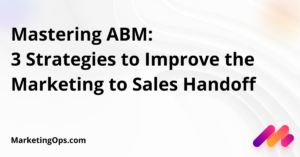I don’t know about you but it’s pretty crazy to me how a simple workflow or automation can make a drastic impact on someone’s day-to-day work. Something as simple as fixing a sync error between two systems or automating an email to be sent when an opportunity has been marked as “Closed Won.” Considering you know your tech stack inside and out, either of these items, in theory, should only take away from a small portion of an 8-hour day.
And while this is a quick thing to come up with, the impact that it could have on another person or team’s day-to-day workflow could be drastic. Imagine automating a closed-won email notification; think about the fact that there are sales teams out there who are carving out hours each week to send emails one by one to all of these associated contacts. In a relatively short period of time, you are changing someone’s job drastically.
It took some reflection for me to realize that one of the most underlooked soft skills amongst the Marketing Ops communities is Change Management.
Anyone Driving Process Innovation Needs to be a Change Manager
In my opinion, for Marketing Operations professionals, going from a Junior to an Intermediate equates to having mastery of your internal tech stack and data flow. To go from an Intermediate to a Senior-level position, you need to have mastery over humans and in our world, which will likely equate to getting other internal stakeholders to adopt a new tool or process.
Our job responsibilities don’t typically reflect being Change Managers but being the ambitious professional that you are (which is how you ended up on this article); I have found that it is an unspoken agreement that you have with your team members, managers, and any other internal stakeholders.
With that being said here are 6-steps to follow next time you want to propose a new solution or change:
1. Find a Shared Purpose through Empathy
As a successful leader, empathy is one of the most important skills one can have which can play a role in almost everything we do both professionally and personally. A simple change can impact multiple people’s jobs in different ways and empathy is how you will be able to best communicate and gain support from others within your organization.
Once you’ve developed a level of understanding of how this is going to impact people, find a shared purpose for all parties. A shared purpose is an outcome that both you and the people you will be working with will collectively achieve together and gets others involved in the process (which you will find is important in the following steps). If you want to learn more about this, take a look at the Strategic Narrative by Andy Raskin and while he talks about it within the context of branding typically, the principles still apply to how we communicate with each other.
2. Prepare Leaders for What You’re About to Implement and Get Buy-in
One of the biggest challenges and reasons why a change won’t be successful is because there was a communication breakdown between someone who has a stake in your proposed change and unfortunately; it’s typically from a manager or team leader. As owners and evangelists of what we are building, it’s our job to communicate the purpose behind these changes to all levels of the organization: from the top all the way down.
From personal experience, I’ve noticed that oftentimes, people love the idea of something and the potential it may have but as soon as it involves someone changing the way they do a particular task, the tone can change. To get buy-in, you must have a clear understanding from other people’s perspectives of how something is currently working, why it’s not the best way for them to do the particular task, and how this new way is going to make their lives easier.
Human beings are inherently selfish and we all want to do things that are best for our own interests. The more you can align your initiatives/changes with someone’s selfish needs, the more likely you will get buy-in.
3. Find your Evangelist, Champion, and ‘Owner’
One thing that I’ve come to realize, and not as quick as I would have liked to, is that you can’t be the only expert on the tool. To be the best MOPro you can be, in my opinion, you should enable people to know how their tools and systems function for day-to-day use better than you.
For example, I believe that the Marketing Operations role shouldn’t be the first person other users go to in order to figure out how to send an email to People using your new Sales Enablement tool but rather, they should be the person dealing with issues like data sync errors and proposing new processes or integrations within your tech stack.
This may require a bit of an ego-check and you will definitely feel like you’re losing a bit of control but in the long-term, it will enable you to focus on driving innovation within your Marketing Tech Stack.
4. Provide Ongoing Support and Reinforcement (even when it’s hard)
In the early stages, you will be the internal expert for the change and solution you are implementing for both the technical and non-technical aspects. It’s our job to reinforce this change, which can look different depending on the seniority and responsibilities of the stakeholders, and support people throughout the adoption lifecycle.
Your goal during this time should be to enable people to take some level of ownership in the new way of doing things. The skills and career path that you have chosen is scarce and while 25% of people Marketing Ops professionals are the solo-team member, you need to do yourself a favor and not be the bottleneck of every process so that you can focus on the work that will drive the most impact.
5. Post-Technical Implementation Timeline
In my experience, I have often seen teams account for the time it takes for the technical implementation and then they wrap it all up with an hour of end-user training. I can’t point to the source, but I remember reading somewhere that to successfully implement a new tool to its fullest extent, you need to budget approximately 6-months, and the technical implementation, depending on the complexity of an organization’s tech stack, is just the tip of the iceberg.
This will help manage expectations for you and your manager as you go through the entire implementation lifecycle.
6. Clearly Showcase Why this New Way is better through Early Wins
Congratulations! Your project is complete and now it’s time to do a bit of humble-bragging. Throughout this process, there will likely be some minor headaches but its important to show why these are just minor growing pains and showcase how even though there may have been some mild turbulence, it’s temporary and these early wins are just the beginning of how this is going to make everyone’s lives easier.
Wrap-Up: Not all Changes are the Same.
I think it goes without saying that not all changes are the same but from a high level, they should all follow a similar path, regardless of whether the change lifecycle is a week or a year. Always remember that the most unpredictable variable that we will deal with in our jobs is other human beings and we need to always keep that in mind.
I hope you enjoyed this. If you want to learn more about me, you can check out my website and feel free to connect with me on LinkedIn.
Chat soon,
Allan L.






